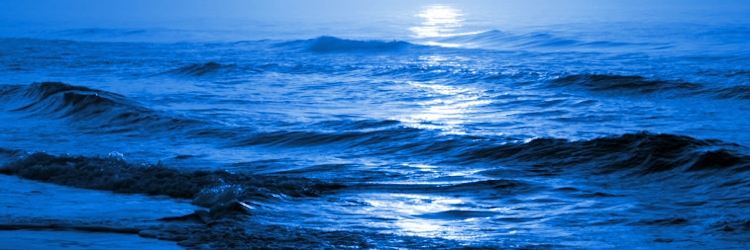Tsunami
Waves of Destruction

Author
Susanna Musick, Virginia Sea Grant, Virginia Institute of Marine Science
Grade Level
9-12
Lesson Time
1-1.5 hr
Objectives
- Explain the physical processes and characteristics of tsunamis.
- Plot latitude and longitude and interpret tsunami travel times.
- Evaluate historical tsunami statistics from NOAA.
Tsunami, Period, Velocity, Magnitude
Materials Required
Copies of the Tsunami travel time map
Summary
Using tsunami time travel maps, predict how long it will take a tsunami to reach the shore. Introduction
On Saturday, December 25, 2004 at 07:58:53 PM (EST) an underwater earthquake caused tsunamis to crash into coasts around the Indian Ocean basin, claiming almost 230,000 lives and causing severe destruction. What are the underlying physical and geological forces that create these devastating natural phenomena?
A tsunami is a wave, or series of waves, generated in a body of water by a disturbance that vertically displaces (moves up or down) the water column. Earthquakes, landslides, explosions, volcanic eruptions, and meteorites can generate tsunamis.
Earthquakes can cause tsunamis when large areas of the sea floor move and vertically displace the overlying water. If the sea floor movement is horizontal, a tsunami is not generated. After a large-scale vertical sea-floor movement, waves are formed when the displaced water mass travels across the surface of the ocean.
Tsunamis differ from wind-generated waves (the kind you see at a lake or at a coastal beach) because they are characterized as shallow-water waves, with long periods and wave lengths. A wave becomes a shallow-water wave when the difference between the water depth and its wave length gets very small. Wind-generated waves usually have periods (time between crests) of 5 to 20 seconds. Tsunami periods are usually between 5 minutes and an two hours.
Tsunamis transform when they move from the deep water of the open ocean and travel into the shallower water near the coast. Tsunami velocity or speed is dependent on the depth of water through which it travels. When the water depth decreases, a tsunami slows, but its height increases. So, a tsunami that may have been hardly noticeable at sea can grow to several meters or more at the shore.
In the case of the Indian Ocean tsunamis, a megathrust earthquake of a magnitude 9.0 occurred at the interface of the India and Burma plates. In the region of the earthquake, the India plate usually moves toward the northeast at a rate of about 60 mm/year relative to the Burma plate. The earthquake rupture was approximately 150 km in width.
In the U.S., the Tsunami Warning System (TWS) monitors seismological and tidal stations throughout the Pacific Basin to evaluate earthquakes and disseminate tsunami warning information. Residents in some tsunami prone areas are taught to recognize the approach of a possible tsunami through a warning siren and signs such as exposure of the ocean floor. Since the Tsunami Warning System functions only in the Pacific Basin, the December 26 earthquake epicenter was located outside its Area of Responsibility. If this had not been the case; and given the massive scale and magnitude of the Indian Ocean earthquake, could its consequences have been predicted or relayed to nearby communities?
Data Activity
Using the Tsunami Lab site, let's estimate the approximate travel times of the tsunami onshore. We'll plot the latitude and longitude of coastal towns bordering the Indian Ocean and see approximately how long it took for the tsunami to reach them. (Students can also locate these points on a globe or world map.)
Open the Tsunami Lab site.
- Click on the tsunami travel time map and print it out. (Hit Ctrl P to print.)
- Plot the latitude and longitude of the cities listed below on the map and record the estimated tsunami travel times for the cities.
- Port Blair, Andaman, India: 11.667 degrees latitude; 92.733 degrees longitude
- Banda Aceh, Indonesia: 5.500 degrees latitude; 95.333 degrees longitude
- Phuket, Thailand: 7.867 degrees latitude; 98.367 degrees longitude
Repeat using the latitude and longitude for other coastal sites affected by the tsunami (you can research affected towns by searching national news sites).
DISCUSSION QUESTIONS:
- What is the average length of time it took for the tsunami to arrive at the cities above?
- Would there have been enough time to warn residents of Banda Aceh, Indonesia after the earthquake took place?
- If there had been sufficient time, how could these shoreline communities have been warned of the approaching tsunami?
Now let's take a look at tsunamis from a historical perspective. Visit the Tsunami Statistics page from NOAA. Examine the graphs presented and answer the following questions:
DISCUSSION QUESTIONS:
- What is the average number of tsunamis that occurs each decade?
- What is the average number of damaging tsunamis that occurs each decade?
- Where in the world do most of the damaging tsunamis occur?
- Is the overall number of tsunamis increasing?
- Is the number of damaging tsunamis increasing? Why? (Hint: Do more people live on the coast now than in 1900?)
- What measures can we take to avoid a further increase in tsunami damages?